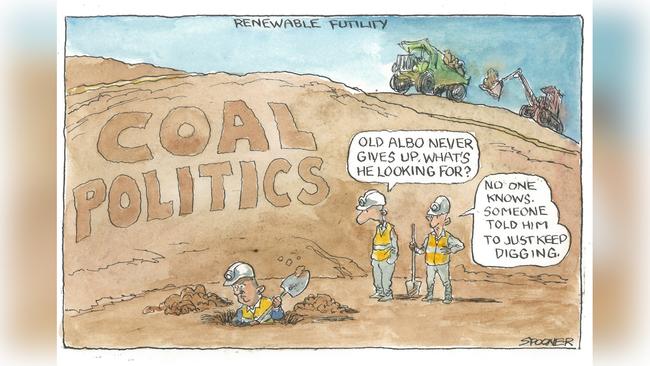Miner issues hold major woes for Labor

Despite some pretty lacklustre leadership from Anthony Albanese, assisted by the invisible Jim Chalmers, a bloke who puts the word shadow into shadow treasurer, the barnacles have been building up on the Good Ship Coalition since 2019.
Given its skinny 2019 majority, the Coalition really can’t afford to lose any seats at the next election.
But, since 2019, redistributions have gone Labor’s way, the Coalition’s Fortress WA remains under siege at the state and federal levels, Victoria looks like continuing its drift to the woke left, and the NSW Coalition has been sinking into a mire of its own making and dragging down the feds with it.
As for Queensland, well, surely the state’s Liberal National Party could go only downhill from the 2019 election, when it won 23 out of 30 seats with 58.4 per cent of the preferred vote.
So why have the odds started to swing back to the Coalition? Three reasons, really.
First came this month’s budget, of which Socialist Left member Jim Cairns – treasurer in the Whitlam Labor government – would have been proud. The audacity of the depth and breadth of the Coalition spending caught Labor flat-footed.
Moreover, its leadership team still seems incapable of any sort of credible response.
Second, only a matter of days before the Upper Hunter by-election last Saturday the Coalition managed to find a lazy $600 million lying around to promise it would whack up a 660-megawatt gas-fired power station at Kurri Kurri, home of the Big Kookaburra and just down the road from the state seat of Upper Hunter and the marginal federal seat of Hunter – only a short drive from potential workers and voters living in Maitland and Cessnock.
Who would have thought? What a coincidence.

Third came the by-election for Upper Hunter the following Saturday, after weeks of dithering by the federal Opposition Leader about Labor’s position on the future of coalmining jobs.
You can slice and dice the Upper Hunter results pretty much any way you please. The Nats and Labor shed a combined 10 per cent of their primary votes, so both of them were on the nose. The Shooters, Fishers and Farmers Party shot itself in the foot, shedding more than 10 per cent of its vote. One Nation smelled an opportunity and ran a strong pro-coal line, digging up more than 12 per cent of the vote. And, finally, the pro-Liberal green movement represented by local farmer Kirsty O’Connell (supported by another local farmer, Malcolm Turnbull) attracted more than 8 per cent of the primary vote, showing that independent Liberal candidates still could play a role at the next federal election. So, every party loses or wins a prize, really.
But the fact remains the Coalition faced this by-election having lost an MP it would prefer to forget and he had left behind him a seat on a pretty thin margin of 2.6 per cent after preferences. After the booths closed last Saturday, the Berejiklian government looked like finishing the night on about 55.4 per cent, after a swing to the state Coalition of nearly 3 per cent.
We should be cautious about translating a bad state result for Labor into the federal arena, but in this case the link is the key mining vote and is typically common to state and federal elections.
Until the mid-1960s, the Labor Party and labour movement basically were the same group in strong mining seats, such as Hunter, held by Labor MPs since 1910. If you worked in the mines, you were in the union, and if you were in the union you voted Labor, and so did your family and your neighbours. From 1966, the vote for Labor in mining seats began a long-term decline, with the profile for miners falling into negative territory in 1998 (see chart). By 2019, male miners were as big a negative driver for Labor as they had been a positive driver in 1966.
In other words, you were likelier to find miners in Coalition seats than Labor seats and the stats were significant to more than 99.9 per cent confidence levels.
In 2019, the three seats with the largest 10 per cent-plus swings to the Coalition were Dawson, Capricornia and the above seat of Hunter, three of the top eight seats for male miners as a share of the male workforce.
The first two of these mining seats – Dawson and Capricornia – are now held by the Queensland LNP, with Hunter, the former rock-solid Labor seat, reduced to marginal status on 52.5 per cent two-party-preferred for Labor.
In fact, of the top eight seats for male miners, all but Hunter elects non-Labor MPs. On the same swing we saw in Upper Hunter last Saturday night, Hunter, too, would fall to the Coalition.
For Labor’s federal and state leadership teams, dithering over the future of coalmining jobs is no longer an option. The punters on both sides of this argument want leadership.
John Black has pioneered demographic and political profiling in Australia since the early 1970s. He is a former Labor senator for Queensland and is executive chairman of profiling company Australian Development Strategies. Some of the material referred to above can be found at elaborate.net.au.



Up until the May 11 federal budget and last weekend’s Upper Hunter state by-election in NSW, I’d been thinking the odds were building against the Coalition winning the next federal election.